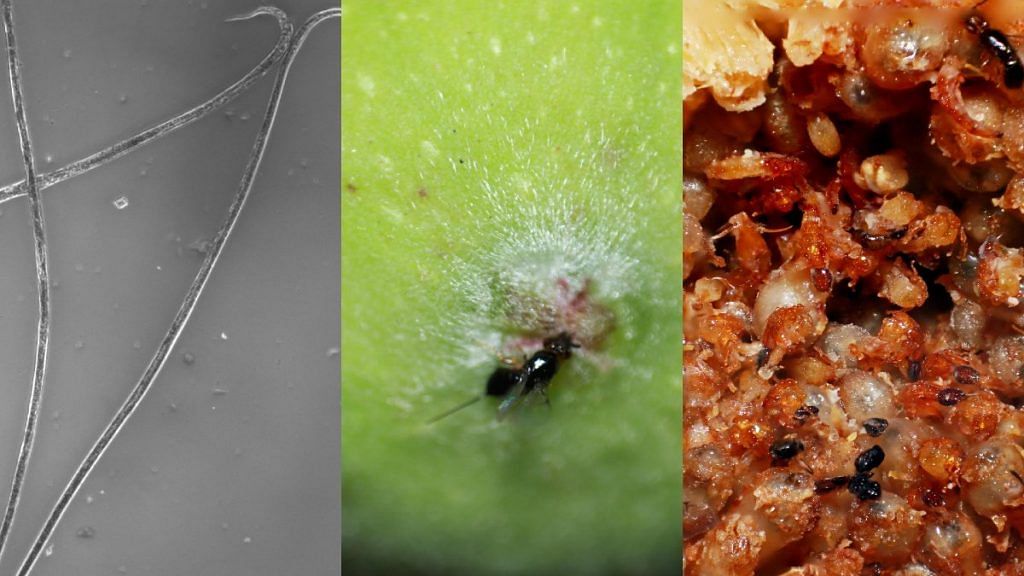Pune: In the flowering regions of south Indian fig trees live parasitic worms — known as nematodes — that hitchhike for survival. Their vehicle of choice is a very specific set of female pollinator wasps, and the worms have a special ability to spot them.
Now, scientists at the Centre for Ecological Sciences, Indian Institute of Science (IISc), Bengaluru, have discovered how two species of the worms find who exactly to hitch a ride with.
One of the ways they do this is by scent — the IISc researchers say the worms use volatile or gaseous chemical compounds, like a perfume, to recognise signals from wasps.
According to the researchers behind this study, the findings can prove crucial by aiding efforts to conserve the fig ecosystem and make it more productive, and mitigate a factor that takes a toll on pollination.
Female fig wasps are the sole pollinators of the fig plant, and thus play an important role in maintaining the ecosystem. If the number of nematodes per wasp is high, the researchers observed in an earlier study, it leads to adverse effects on the fig plant, like reduced size and seed number, as well as reduced lifespan of the wasp and the time it can fly. This can cause the fig ecosystem to collapse.
While the researchers studied nematodes from fig trees in south India, the same fig tree species has a wide geographical distribution in India, Southeast Asia and Australia.
“By identifying and characterising all the volatile compounds involved in this decision-making process, new mechanisms can be developed to control the nematodes hitchhiking on the fig wasps, and (this) can thus increase the productivity of the figs and the fig wasps,” said Satyajeet Gupta, first author of the study, which is featured as the cover story on the February 2021 issue of the peer-reviewed Journal for Chemical Ecology.
“By understanding how these less-studied species of nematodes decide which wasp to use as their transport to different environments, we can design mechanisms to regulate the vehicle-passenger relationship so that they can coexist without harming the ecosystem,” he added.
Also Read: IISc study says Covid virus now mutating much faster, variants in India have multiple origins
‘A remarkable ability’
The nematodes in question grow and live in the flowering regions of the fig tree, commonly referred to as ‘atti’ in south India. These regions later develop into fig fruits.
However, this environment is short-lived since it can be eaten by other animals that feed on fruit, which forces the worms to move to new regions.
They do this by hitching a ride on fig wasps that fly between fig trees to help in pollination, often over large distances. When at a young stage, these worms climb on to female pollinator fig wasps and enter their gut, travelling from one fig tree to another.
Even though there are six other wasp species that fly between the same trees, these nematodes have the ability not only to identify the exact species of pollinator fig wasps to hitchhike on, but to spot one particular set within this species.
It is this decision-making ability in two nematode species that the IIsc team set out to explore.
The research group previously observed that these nematodes were able to choose their vehicles by checking how crowded the gut was with other hitchhikers, and if there were other members of its own species already present. If they travel with their own species, they have a better chance to find mates when they reach their new habitable destination, the researchers said.
In addition to the volatile compounds, the nematodes also choose their vehicles based on the level of carbon dioxide released by the wasps when they respirate, since this could indicate the functioning state of the wasp bodies i.e., if the wasp is alive or dead.
“For most animals, differentiating between different living states of other individuals is difficult and they take a long time to figure this out. However, these nematodes are very sensitive to the minor changes in these compounds, and can determine deaths almost immediately. The precision with which the nematodes make this choice is remarkable,” said Gupta.
This sensitivity is particularly useful since the environment of the fig flowering region is crowded with many different chemical signals from other nematodes as well as other wasp species, the researchers note.
The research group demonstrated that when the nematodes are given a choice, they hitch a ride with live wasps rather than dead ones, which suggests their priority is to be able to get out of that environment. But when they aren’t offered a choice, they were also attracted to dead wasps, which could indicate that these nematodes might also thrive on the bacteria or fungi that grow on the dead animal or by feeding on the carcass itself.
Anoushka Dasgupta is a freelance science writer, with a Master’s in Biotechnology from University of Pune
Edited by Sunanda Ranjan
Also Read: Citizen science: How India’s conservationists are mapping wildlife to protect it
